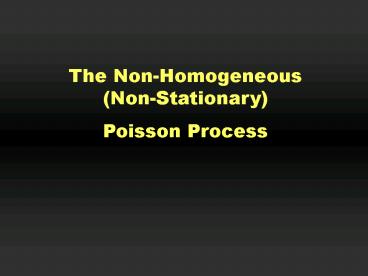The NonHomogeneous NonStationary - PowerPoint PPT Presentation
1 / 21
Title:
The NonHomogeneous NonStationary
Description:
in many applications, we would like the arrival process for a queue to ... Decoded Signal T=0.1. Some Non-Homogeneous Poisson Processes. neuron spike activity ... – PowerPoint PPT presentation
Number of Views:38
Avg rating:3.0/5.0
Title: The NonHomogeneous NonStationary
1
The Non-Homogeneous (Non-Stationary) Poisson
Process
2
The Non-Homogeneous (Non-Stationary) Poisson
Process
- in many applications, we would like the arrival
process for a queue to incorporate time of day
effects
3
The axioms become
- P(two or more events in t,th)) o(h)
- number of events in non-overlapping intervals are
independent
4
If we define the mean-value function
5
Also, if we define T(s) to be, at any instance s,
the random amount of time until the next arrival,
we can show that its pdf is
6
One Method of Generation
- simulate a homogeneous Poisson process and
rescale the time
Specifically,
Proof is homework!
7
Another Method of Generation
- thin the process
Lewis and Schedler (1979)
8
Why this thinning works (heuristics)
9
Poisson Processes in Signal Encoding
- I want to send you a message (signal).
- While in transit, that signal gets corrupted by
noise.
- You filter out the noise to retrieve the
message.
Example Radio transmissions get corrupted by
electromagnetic signals.
Free book http//ee.stanford.edu/gray
10
Poisson Processes in Signal Encoding
Think of the message as a function x(t), that
varies over time.
11
Poisson Processes in Signal Encoding
and you receive this
12
There are several ways to filter out the noise.
Example Kalman Filter
- gives an estimate whose expected value is the
true signal
- gives an estimate with minimum variance
- pretty ugly diversion from our course
- take a time series course
- visit www.cs.unc.edu/welch/kalman/
- talk to Debbie!
13
Poisson Processes in Signal Encoding
- transmit a signal
receive it
filter it
there is error
- encode a signal with a NHPP
transmit encoded signal
receive it
filter it
Increase system robustness against noise
un-encode it
there may be less error
14
Poisson Processes in Signal Encoding
Let x(t) be the signal (real-valued function) to
be sent.
Assume max x(t) lt A.
and by marking each Poisson arrival with a
positive or negative sign I(t) sign(x(t)).
15
Poisson Processes in Signal Encoding
Original signal x(t)
Encoded Signal P(t), a850 pulses
1
0
-1
16
Specifics of the encoding
- suppose that x(t) is constant over an interval of
length T
- distribute them uniformly over the interval
17
Un-encoding
- fix a small time window of length T in which you
will assume the signal x(t) is constant
- estimate the constant rate of the Poisson process
in this window by
- counting the number of arrivals in the window
18
Un-encoded signal
Decoded Signal T0.01
Decoded Signal T0.1
19
Some Non-Homogeneous Poisson Processes
20
Some Non-Homogeneous Poisson Processes
A convenient rate function
(type of Weibull)
- In this case, the time dependent component of the
rate function enters multiplicatively.
Hence, we have the following interpretations
21
A Non-Homogeneous Poisson Processes
- Suppose each customer stays in the store for a
random time X with cdf F.
- Let N(t) be the number of customers in the store
at time t. (Assume N(0)0.)































